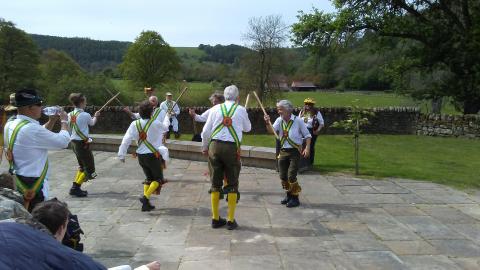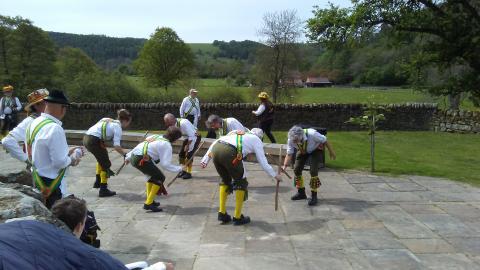Kemp’s Men

I was entertained over the weekend by a troupe of Cotswold Morris Dancers from Norfolk, touring North Yorkshire’s market towns and historic sites. This particular group, Kemp’s Men, were suitably bedecked with jingling bells and armed with handkerchiefs and sticks which they waved and beat respectively. Morris dancing is an old English custom, the first records for which date back to the fifteenth century. The term may originate from Moorish, referring to the Islamic, Arab culture of Spain, which seemed wonderfully exotic to northern Europeans. Furthermore, some dancers, especially in Rossendale, blacken their faces and the clashing of sticks may be a recreation of the Spanish-Moorish wars.

The Our Warwickshire website quotes the county’s Quarter Sessions (magistrates courts) for Easter 1655 ordering the suppression maypoles and Morris dancing, which is described as a “heathenish and unlawful custom…the observation whereof tendeth to draw together a great concourse of loose people and consequently to the hazard of public peace besides other evil consequences.” I must say the dancing I watched was thoroughly reputable, enjoyed by a dozen or so middle-class English Heritage card-holders.
I suspect the puritans were right in that respect: this energetic gyration predates Christianity and has its origins in our pagan past as some fertility rite performed in spring and early summer. There’s little real evidence for this, but then we wouldn’t expect pre-Christian Celts to write things down. As the Towersey Morris website declares ‘We, and all other Morris sides, dance to bring good luck, fertility to the soil and our fellow human beings’.
Our culture’s abandonment of its Judeo-Christian heritage and obsession with sexual identity and unbounded hedonism is bringing us full-circle to the paganism from which we were once delivered. Although a conservative Christian like me regrets such a reversion, a part of me secretly hopes it will result in a revival of Morris dancing, which I rather like.

- Log in to post comments


 Sunday Worship 10.45am & 6.00pm
Sunday Worship 10.45am & 6.00pm